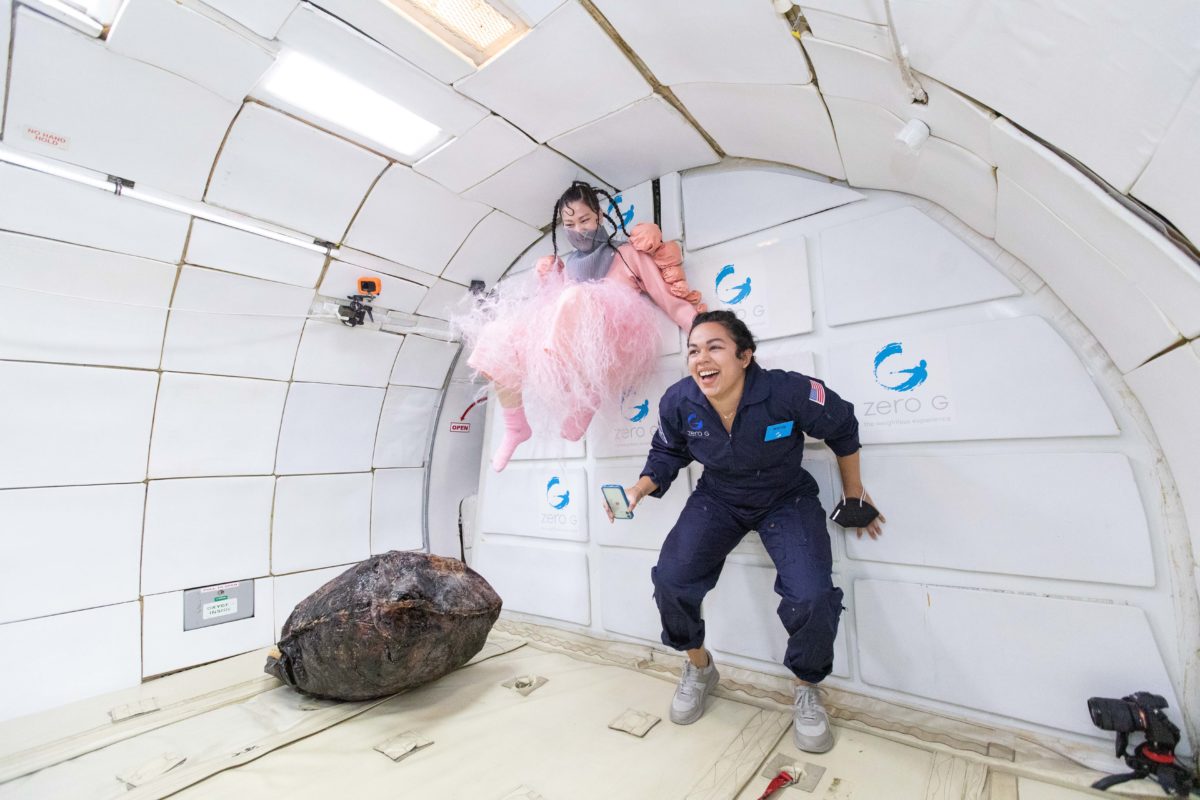In a new video art piece, MIT alum Rae Yuping Hsu counters traditional narratives of colonization
In late May, 20,000 feet above Pease, New Hampshire, a woman dressed as a microbe in a spacesuit inoculated with slime mold bounced around in a microgravity parabolic flight airplane. A giant inflatable SCOBY (symbiotic culture of bacteria and yeast, and the main ingredient of kombucha) she had made bounced nearby. Halfway through the two hour flight, these two “beings” collided. The woman opened up the SCOBY, and climbed in. In this moment of exchange, or “first contact,” these two organisms combined and bounced around as one for the remainder of the flight.
If this sounds like science fiction, it isn’t. With Jeff Bezos, Elon Musk, and others racing to space, and the recent military reports of UFOs, Rae Yuping Hsu, in collaboration with Nancy Valladares, both 2020 graduates with a SMACT in the Art, Culture, and Technology program at MIT, employs performance art and video to suggest alternative imaginaries regarding our first encounters in space. “I feel a certain urgency to create a new narrative that would lead to more socially just futures,” Hsu says. No more manifest destiny, or outdated colonial ways, as we forge new relationships on other planets. Her project, Panspermia, a performance of symbiosis in microgravity, funded in part by The Council for the Arts at MIT (CAMIT)–a group of alumni and friends with a strong commitment to the arts and serving the MIT community–culminates in a video art piece viewable on her website.
Being an artist at MIT
“I knew little about space technology, and was never a big Star Trek fan,” says Hsu. The idea came from a lecture in the Media Lab class Prototyping our Sci-Fi Space Future: Designing & Deploying Projects for Zero Gravity Flights. The class and associated zero-g flight opportunity are funded by the MIT Space Exploration Initiative, whose mission is to make space technology more approachable, and to democratize access to space. Hsu emailed a proposal to Ariel Ekblaw, the founder and director of the initiative, who gave her a spot in the class. “Being an artist at MIT affords you collaborations you may not have thought of,” says Hsu.

One guest in the class was an expert on space food, another discussed the philosophy of space travel. Another said a main reason to journey to space is “manifest destiny.” The same kind of manifest destiny, thought Hsu, “that justified colonial settlers taking over indigenous land.” She thought about how life started on Earth and imagined life on other planets, even if life meant only bacteria.
She recalled a hypothesis known as “panspermia” that suggested life on Earth came to us by microbes that were carried here by comets. The biologist Lynn Margulis’ endosymbiosis theory was another inspiration. Combining these frameworks with the idea of “first contact,” she began to imagine Panspermia.
How we coexist with otherness
Hsu had already been fermenting kombucha since taking MIT’s How To Grow (Almost) Anything class. For this project, she grew the SCOBY for six months in large plastic tanks in her studio. She dried it then constructed a large inflatable. She inoculated the spacesuit with slime molds because they are known to be exemplary organisms in demonstrating collective intelligence and therefore represent multi-species survival in space.
Hsu hasn’t always worked as an artist; she was trained as an occupational therapist in Taiwan. She worked in a hospital with patients who suffered from phantom limb pain. She used neurotherapy to help trick their brains into fixing whatever was causing the pain. It was in that work that she began to think about “otherness in the body.” Even though she had a background in medicine, and was taught to look at herself as a whole organism, she began to doubt “the notion of an individual and started seeing this phenomenon that pointed towards how we as human beings can coexist with otherness,” she says.
In speaking with patients, she began to see the power of storytelling and art to change narratives. She left medicine, and enrolled at RISD, where she received an MFA. Since then she has won numerous awards including 2nd prize for the Schnitzer Prize in the Arts at MIT in 2020 for her work “yellowsoup”, a first prize Ilona Karmel Enterprise Poets Prize for Imagining a Future for her thesis “In Between Empathy and Wonder Lies the Contamination that Makes Us Human,” and a MIT Transmedia Storytelling Initiative fellowship. Her work has been exhibited not just at MIT but around the world, in venues from Taiwan to Madrid. She now lives and works in New York City.
Change what “first contact” means
Before enrolling at MIT, Hsu attended a residency at SymbioticA in Australia, one of the first centers for biological art. There, she learned how to cultivate human cells, and to think about her material as having its own agency. She discovered that synthetic biology all started at MIT, and learned about the How To Grow (Almost) Anything class. She realized MIT was where she needed to study in order to have access to “all the most advanced biotechnology the world has to offer right now.” In this class, she learned CRISPR, advanced imaging, DNA sequencing, and fermenting; but she also discovered that she “was less enthusiastic about learning state of the art biotechnology, and more interested in the narratives the field was telling.”
It’s very common for people to say, “let’s colonize Mars in three years,” imagining a better future. But “they never really define what better is, and better for whom,” says Hsu. She hopes to pose questions with her art practice about whether or not we can change what “first contact” means. Maybe it doesn’t have to mean a moment of colonizing, or being colonized. Maybe it can be a moment of exchange. Let’s hope so.
Written by Sarah Baker


